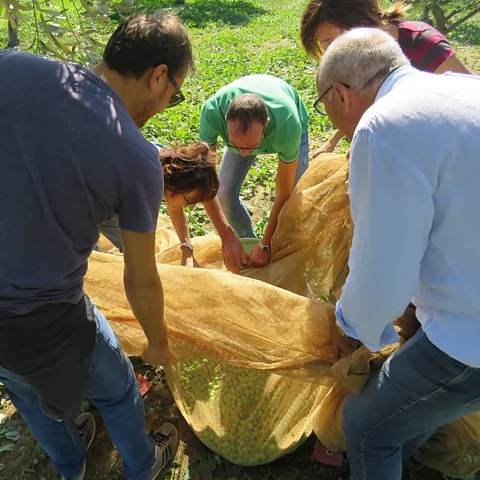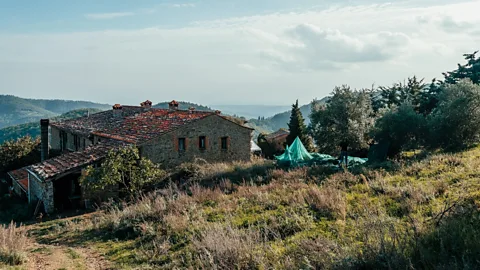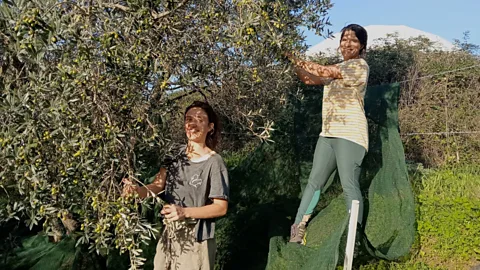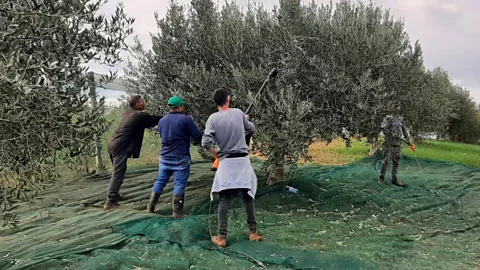How to join an Italian olive harvest
 Adriana Calvaruso
Adriana CalvarusoHarvesting olives to make olive oil is an ancient Italian ritual that's increasingly under threat. Now, some believe it might just be the next frontier of Italian tourism.
Rubber boots squelching in the mud, I squint up at a mosaic of branches and scan the leaves. I've been at this for hours; my eyes blur. But there, at the top of the tree is one last cluster of purply-green olives.
I raise the handle of my rake – 2.5m long and unwieldy, like the neck of a giraffe. As a splinter pierces my glove, I strike; ripping through the branch with the comb's long teeth. Olives shower down in a green and purple rain.
I glance triumphantly at my husband and mother-in-law. They're too busy combing their own trees to notice.
An Italian autumnal rite
Each October, after the beach umbrellas have folded and the air turns crisp, my husband and I retreat to his parents' orchard in Calabria to participate in one of Italy's most delicious autumnal traditions: the olive harvest.
We're not alone; la raccolta delle olive is an ancient ritual across rural Italy, where olive trees have been cultivated for thousands of years and many families still tend generational oliveti (olive groves) to produce the oil they will use in the coming year. No heavy machinery; very few (if any) chemicals; just artisanal extra virgin olive oil (EVOO) that we'll drizzle over everything from soups to salad.
 Adriana Calvaruso
Adriana CalvarusoBetween mid-October and early December, from Sicily to Lake Garda, the raccolta pervades daily life. Weekends are spent harvesting and transporting olives to the local frantoio (olive mill), where they'll be pressed into oil, then bottled and stashed in the pantry until needed. For weeks, we pick leaves from our hair, scrub olive pulp from our nails and wrap warm towels around our necks; stiff from peering up into the branches.
The work is exhilarating – and it might just be the next frontier of Italian tourism.
In the last few years, oleoturismo (olive oil tourism) has been on the rise in Italy. A growing number of olive farmers have expanded their ancestral groves or bought hectares of abandoned trees to cater to tourists. Some are opening agritourisms, while others are offering tastings or experiences where guests can stroll through the groves and even participate in the harvest itself.
 Angela Davis
Angela DavisWhat is mere housekeeping for my in-laws and friends is becoming a coveted experience for international travellers and Italians longing to return to tradition.
"When I was a child, we all did the harvest together," recalls Adriana Calvaruso, customer liaison for Quartus olive oil farm in Alcamo, Sicily; an offshoot of her grandparents' grove. "It was a moment of sharing, of celebration. All our generations, united by this passion. In the evening, when you smell the olives you've harvested with your own hands, it's like inhaling the scent of home."
Quartus, which Calvaruso operates alongside her parents, transmits that generational love with bespoke olive grove experiences, welcoming visitors to watch their more than 1,300 trees being harvested each October: "The process is as manual as possible, not using industrial machinery that stresses the trees. In the evening, we visit the mill to see the pressing."
A tasting naturally follows, "either on the farm, where the harvest takes place, or at the mill". The bold flavour of EVOO is sampled in oil "flights", savoured like a nice Chianti to access the olives' myriad flavours.
 Bio Agriturismo Reggioli
Bio Agriturismo ReggioliSome properties even allow visitors to pick up a rake themselves; a return to nature increasingly less common in modern Italy, says Christian Reggioli of the Bio Agriturismo Reggioli in Monteluco, Tuscany.
Originally from Italy's northern Alps, Reggioli fell in love with the countryside tradition as a young man. "For me, it's about a return to the land," he says. "I grew up in a touristy village where it snowed half the year, so agriculture was somewhat lost there. I wanted to reconnect with nature more directly, through this lifestyle."
At the farm, Reggioli says: "People help pick and press the olives to make their own oil for the whole year. Some guests stay for a week or two, or even for a month… In the morning, we all have breakfast together, then go to the fields. People form groups of three or four per tree, lay nets underneath, then start collecting."
Like wine, olive oil's taste is dependent on the varietal, soil and weather conditions. "Real oil is different every time," says Reggioli. "We bring olives to the press every few days; each time, something new comes out. A new adventure, a new flavour, a new colour."
 Bio Agriturismo Reggioli
Bio Agriturismo ReggioliCase in point: my in-laws' Calabrian olives grow inland on a rocky plain, but six hours north in Terracina where my husband and I live, our friend's trees grow in the mountains overlooking the Tyrrhenian Sea. One night after the harvest, we invite her to dinner, planning to swap our new EVOO. Our menu is Italian autumn on a plate: risotto alla zucca (pumpkin risotto) and roast chestnuts. Her oil – audaciously peppery and bright – is a stark contrast to our mild, floral offering.
More like this:
• Italy's national parks are perfect for foodies
• Why luxury travellers are paying to work for their dinner
• The return of Sicily's ancient 'white gold'
"Our guests love learning how to recognise real EVOO," says Lucia Leone, oil sommelier at Masseria il Frantoio in Ostuni, Puglia; a 16th-Century luxury farmhouse offering a variety of olive oil experiences. "Real EVOO is fruity, fresh, bitter and spicy. If you don't taste those notes of tomato leaf, fresh-cut herbs or artichokes, the oil isn't extra virgin."
Monica Bisignano Zamler runs food and lifestyle tours in Italy, including a harvest experience where travellers can try their hand at collecting olives. "Tourists who've travelled to Italy before have seen the monuments; they've seen the Coliseum, they've been to Venice," she says. "Now people are looking for more experiential travel in foreign countries; they're really starting to recognise that it's important to see how other cultures live and what their day-to-day lives are all about."
An endangered tradition
La raccolta may be part of everyday life in rural Italy, but as Italians continue to migrate to larger cities for economic opportunities, hundreds of thousands of family groves have been abandoned in recent decades. Throughout urban Italy, industrialised mass olive oil production reigns; three in four bottles of olive oils purchased in Italy now come from overseas.
"The tradition is being lost because there isn't an appreciation for it," says Reggioli. "Until 30 years ago, even Tuscan families who didn't own groves would buy 50 litres of oil directly from farmers. Mothers aren't at home cooking anymore. People now live in small apartments, without large pantries to store many bottles."
But as so often in Italy, tourism could be the answer.
 Adriana Calvaruso
Adriana CalvarusoLike cheese, EVOO is emerging as a strategic part of Italy's "Made in Italy" identity – a product that embodies craftsmanship, heritage and export potential. The country is home to approximately 400,000 active olive-growing businesses, 250 million trees and 533 native varieties, resulting in the world's richest olive biodiversity. Recognising the economic and cultural value of olive oil tourism, the Italian government included the sector in the national budget in 2020. Since then, Italy's food and wine tourism has seen a 37.1% boom, which industry sources say are "closely tied" to the growth of olive oil tourism.
Plan your trip
Travellers can try their hands at olive harvesting at these farms.
• Azienda del Carmine (Ancona, Le Marche) Agritourism allowing guests to witness an expert-led 360-degree "From olive to oil" experience (early October - mid-November).
• Agriturismo Novole (Cortona, Tuscany) Agritourism set in a 15th-Century village in the Tuscan hills. Participate in the harvest then enjoy bruschetta, wine and roast chestnuts in front of a roaring fire (end of October through early December).
• Tenuta Torciano (San Gimignano, Tuscany) Offers one-day olive harvest experiences throughout the month of November.
• Casa Migliaca (Pettineo, Sicily) Offers olive harvest experiences and tree adoption. Lemon grove activities; pottery and language classes are also available (mid-October – early November).
• Maraviglia (Monte San Savino, Tuscany) Participate in the olive harvest for one week in mid-October; extensions into mid-November for private parties upon request.
• Centumbrie (Perugia, Umbria) A network of agritourisms offering EVOO lunch, cooking, aperitif, olive press tour and harvest experiences through December.
Note: the year's weather conditions and harvest output can affect the length of the season.
And those activities keep evolving. The Strada dell'Olio (Olive Oil Road) is a series of olive oil itineraries across the nation. Each autumn, Walking Among the Olive Trees similarly proposes hike, bike and horse trails in 17 Italian regions to introduce visitors to local olive oil culture.
In Umbria, the Frantoi Aperti (Open Mills) host mill visits and gastronomy events; while the "olive oil edition" of the Espresso Assisi train runs between Rome and Assisi each Sunday during the month-long event, with tastings on board (19 Oct – 16 Nov).
Across Italy – particularly in Puglia, Italy's leading olive oil-producing region – a number of farms now offer "adopt an olive tree" programmes which allow people to sponsor trees and receive shipments of oil from their personal plant. At Tenuta Torciano in San Gimignano, Tuscany, for instance, adopters can sponsor a tree for one, three or five years. "We've created an army of people who love freshly harvested olive oil," says owner Pierluigi Giachi. "We attach a plaque to the tree with the adopter's name. They visit [their tree] every year."
Giachi feels that tree adoption and olive oil tourism are instrumental in saving Italy's groves, as well as its beloved tradition. "Seeing the abandonment of what our grandparents built is heartbreaking," he says. "This programme of adopting the olive trees allowed us to save and maintain nearly 80 hectares of groves."
But are guests paying for the privilege of… working?
Angela Davis, who recently attended one of Bisignano Zamler's olive harvest tours, admits, "It is work. But I think the beauty of it is that you're able to step into somebody else's life even if it's just for a moment."
Giachi – who greets arrivals with a rake in hand – confirms that his guests are thrilled to get their hands dirty. "Today, some tourists were supposed to leave after three hours, but they stayed for almost seven. "[Their tour] guides were furious: 'You're not keeping to schedule!' I told them, 'Fine, collect the people who want to leave.' The tourists said, 'Cancel our other activities; we want to stay!' They even stayed for dinner."
"These are the moments that stick with you," he adds. "They learn that olive oil doesn't come from the supermarket; it comes from a tree that has been tended with so much love. Without love, nothing can grow."
 Angela Davis
Angela DavisA labour of love
While olive harvests may increasingly be open to tourists, their roots are forever in the home. When we travel to my husband's childhood home and harvest the olive grove his great grandfather planted, we partake in the same ancient rhythms and rites tourists can now experience: spreading nets around the trunks, using different-sized rakes to reach each branch and listening to the constant whispering of olives falling on the nets like ASMR.
 Adriana Calvaruso
Adriana CalvarusoAs the sky turns amber-coloured, we'll pull up the nets, pick out the branches, then pour the olives into sacks, which are filled to bursting then driven to the frantoio; a warehouse buzzing with workers who haul the olives to the press. We'll watch the olives being macerated, then see the oil as it comes out from the spout; neon green. And after all of our hard work, the reward: we'll enjoy grilled bread with new oil lashed on top, just as our friends are doing somewhere across town – and our great-great grandparents did before us.
"[The harvest is] a moment of conviviality and close contact with nature," says Calvaruso. "It fully represents the beauty of Italy."
--
If you liked this story, sign up for The Essential List newsletter – a handpicked selection of features, videos and can't-miss news, delivered to your inbox twice a week.
For more Travel stories from the BBC, follow us on Facebook and Instagram.
